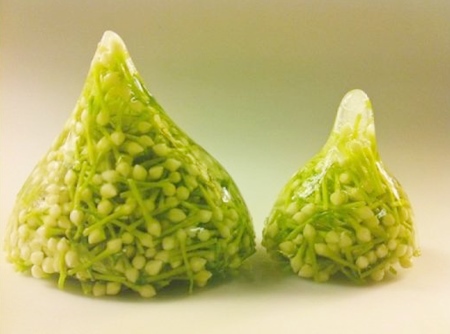Six Thai and French artists currently have their works showcased at a gallery in downtown Bangkok to show their attitudes toward what they call ‘physicality’ in relation to their thinking processes and daily skills or craftsmanship.
The contours of female breasts and wombs not only symbolise the classic aesthetic aspects and dimensions of women and the concepts and practice of sexuality but in some context, it also can convey another dimension, that of maternity, as of a mother giving birth to her child.

Such shapes related to the female figure combined with women’s craftsmanship have been applied by Thai and French female artists to express their thoughts and their perceptions of daily life and their surroundings through the path of time at the exhibition called “Eternity” now on display at Bangkok’s Numthong Gallery
“The Hanger” is one of the artworks spotlighted in the exhibition, which can easily capture the attention of visitors with its meticulous crochet of human hair in a symmetric art form such as a womb, tied to hangers!
The exquisite crocheting skills applied to create the pattern of Thai-style flower pendants not only reveals the feminine instincts of artist Imhathai Suwatthanasilp but it also signifies her interest in the delicate and detailed works of women’s craftsmanship.
Inspired by her deep and warm relationship with her artistic father, who presented the hair from his own head to his four daughters as a symbolic heritage, the unusual inheritance, from parent to children informed her own artistic style. In her exhibition works Imhathai used her own hair to represent her identity and convey her idea about impermanence of life in her work.
“Life is not permanent, [but is] just like a Thai flower pendant. When it completes its task to give nice scent, once it wilts, it is removed from a window. A human body is the same. It is a place where a human soul clings for a period… When we are still alive, we should do good deeds as the flower hanger does its duty,” said Imhathai.
The idea of impermanence and mortality is also reflected in the work of Imhathai’s French artist fellow, Myriam Omar Awadi, whose small pieces of paintings portraying the picture of a man and a woman uniting into one flower-like form like a dry flower kept in a book or a botanical book.
She said her paintings of human figures in similar forms of flowers represent humans, like flowers, are part of the seasons, which symbolizes the passage of time and mortality.
All the human figures in Myriam’s paintings are without heads, she explained. Heads come with responsibility and rationality. Without these two attributes, the human can be lost and can be freed. The slight figures of pairs of dancers in her paintings feature the state of standing and falling down as humans look for balance to live life together.
To further explore acceptance of the passage of time and the moment of eternity when time exists no more as implied in one of Myriam’s works, “Still Life and Little Death”, visitors can come to experience themselves at Numthong Gallery in Soi Aree until March 30.




